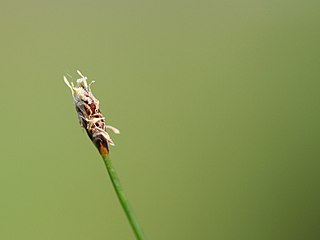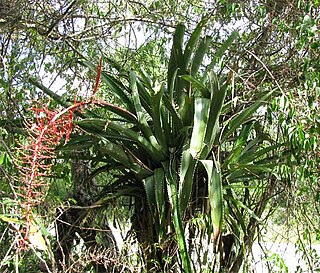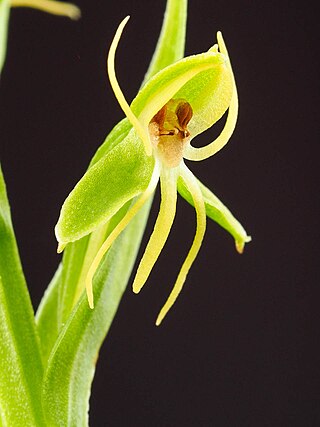
Eleocharis is a virtually cosmopolitan genus of 250 or more species of flowering plants in the sedge family, Cyperaceae. The name is derived from the Greek words ἕλειος (heleios), meaning "marsh dweller," and χάρις (charis), meaning "grace." Members of the genus are known commonly as spikerushes or spikesedges. The genus has a geographically cosmopolitan distribution, with centers of diversity in the Amazon Rainforest and adjacent eastern slopes of the South American Andes, northern Australia, eastern North America, California, Southern Africa, and subtropical Asia. The vast majority of Eleocharis species grow in aquatic or mesic habitats from sea level to higher than 5,000 meters in elevation.

Eleocharis acicularis is a species of spikesedge known by the common names needle spikerush and least spikerush. It is widespread across Europe, central and southeastern Asia, North America and northeastern South America as far south as Ecuador. It is also found in Australia, where it is probably an introduced species.

Cyperus erythrorhizos is a species of sedge known by the common names red-rooted flatsedge or redroot flatsedge. It is found across much of North America from Maine, Ontario and British Columbia south to Tabasco in southern Mexico.

Eleocharis quinqueflora is a species of spikesedge known by the common names fewflower spikerush and few-flowered spike-rush. It is widespread across Europe, North Africa, northern Asia, and North America. There are also isolated populations in Argentina and Chile.
Eleocharis montevidensis is a species of spikesedge known by the common name sand spikerush. It is a widespread coastal plant native to the Americas. It grows in moist, sandy spots in many habitat types, including lakes, riverbanks, wet meadows, and springs. It has a disjunct distribution, in North America and South America.

Eleocharis parishii is a species of spikesedge known by the common name Parish's spikerush.

Eleocharis quadrangulata is a species of spikesedge known by the common names square-stem spikerush and four-angled spikerush. It is native to eastern and central North America, with additional populations in California, Oregon, and west-central Mexico. It grows in and around freshwater in lakes, ponds, and other bodies of water. It is a rhizomatous perennial herb growing one half to one meter in height. The spongy, compressible stem is a few millimeters wide and sharply four-angled. The inflorescence is a single spikelet 1.5 to 7.5 centimeters long which is made up of several flowers covered in light brown bracts.

Eleocharis rostellata is a species of spikesedge known by the common name beaked spikerush. It is widespread across North America, with isolated populations in Argentina.

Tillandsia balbisiana, common name northern needleleaf, is a species of bromeliad in the genus Tillandsia. This species in native to Mexico, Central America, Colombia, Venezuela, the West Indies, and Florida.

Tillandsia bulbosa, the bulbous airplant, is a species of flowering plant in the genus Tillandsia. It is widespread across Central America, the West Indies, southern Mexico, and northern and eastern South America.

Aechmea bracteata is a plant species in the genus Aechmea. This species is native to Central America, Mexico, Colombia, and Venezuela; it is also reportedly naturalized in the Bahamas.

Aechmea lueddemanniana is a species in the genus Aechmea. This species is native to Costa Rica, Guatemala, Belize, Honduras, Nicaragua and southern Mexico as far north as Veracruz.
Catopsis nutans is a species in the genus Catopsis. This species is native to Florida, Central America, Greater Antilles, Venezuela, Colombia, Bolivia, and Ecuador.
Tillandsia festucoides, commonly known as the fescue airplant, is a species of bromeliad that is native to the Greater Antilles, Mexico, the Cayman Islands, and Central America.
Tillandsia pseudobaileyi is a species of flowering plant in the genus Tillandsia. This species is native to Mexico, Guatemala, El Salvador, Honduras, and Nicaragua.

Catopsis floribunda is a species in the genus Catopsis. This species is native to the West Indies, Venezuela, Honduras, Oaxaca, and Florida.

Habenaria repens, commonly called the water-spider bog orchid or the floating orchid, is an orchid species widespread across Latin America from Mexico and the West Indies south to Argentina, as well as in the Southeastern United States from Texas and Oklahoma east to Florida and the Carolinas plus an isolated population in Virginia.

Milla biflora, Mexican star, is a species of flowering plant native to Arizona, New Mexico, Texas, Mexico, Honduras and Guatemala, where it grows at 1,000–2,700 m (3,300–8,900 ft) elevation. It is perennial, growing from a 1–2 cm (0.4–0.8 in) corm, and flowering in summer. Inflorescences of 1–9 white flowers are borne on scapes 4–55 cm (1.6–21.7 in) long. The 2–10 leaves are each 1 mm (0.04 in) wide and half to equally as long as the scape. The fruits are ovoid capsules, 1.5–2 cm (0.6–0.8 in) long.

Dichromanthus michuacanus, the Michoacán lady orchid, is a terrestrial species of orchid. It is common across much of Mexico, the range extending south to Honduras and north into western Texas and southern Arizona.
Habenaria distans, the hammock bog orchid, is a species of orchid. It is native to Latin America from Mexico to Argentina, as well as Florida, the Greater Antilles, and the Galápagos.















